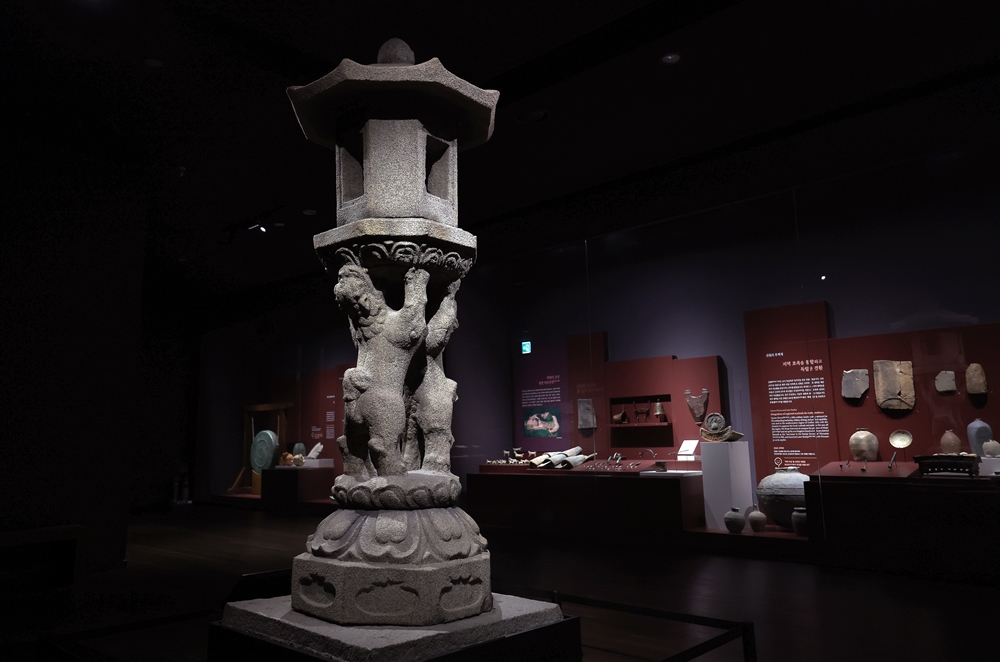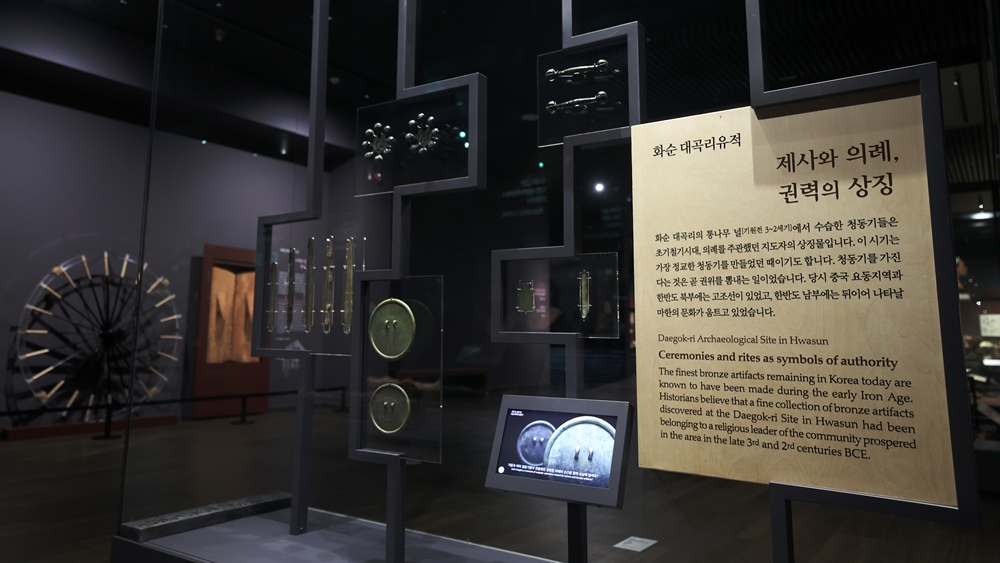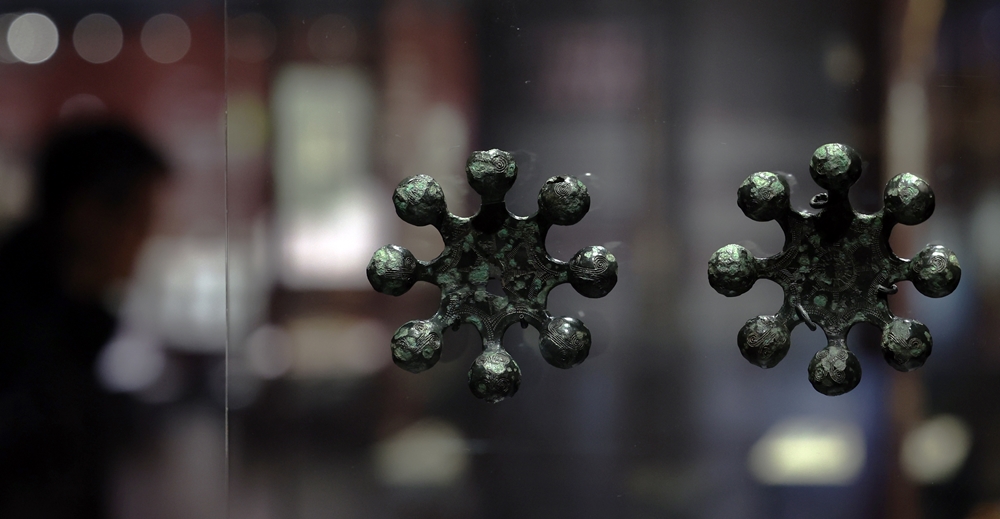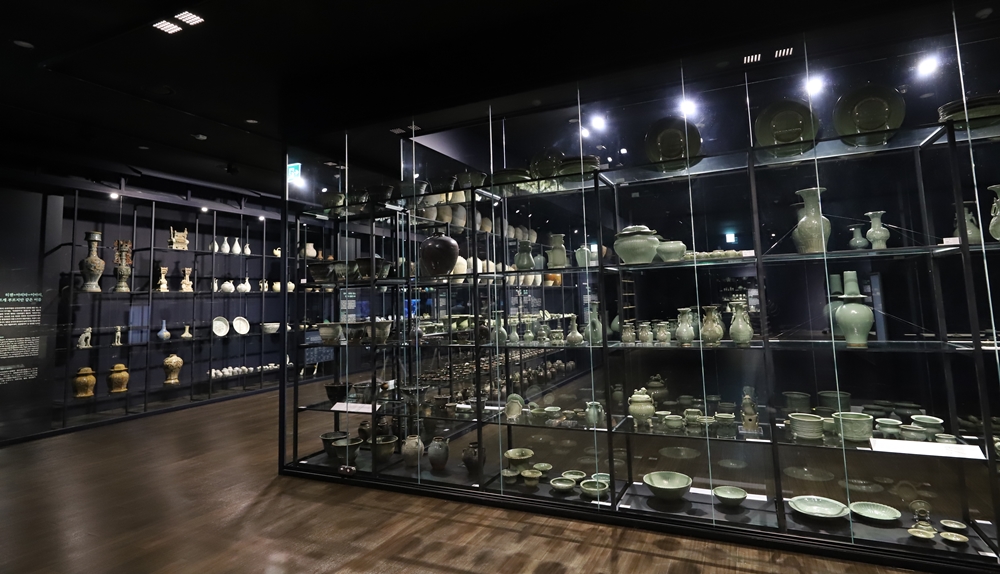박물관은 한 나라의 역사와 문화가 살아 숨 쉬고 과거와 현재, 미래가 공존하는 공간이다. 그 나라가 가진 문화의 힘을 확인할 수 있는 장소이기도 하다. 코리아넷이 대한민국의 지역별 국립박물관 6곳을 선정, 그곳에서 놓쳐선 안될 대표 소장품을 소개한다. 이번에는 광주와 전라남도 지역의 모든 문화와 역사를 한 자리에서 톺아볼 수 있는 국립광주박물관을 방문했다.
A museum is where a country’s history and culture live and breathe and the past, present and future coexist, as well as showing the nation’s cultural power. Korea.net has selected six national museums by region to introduce leading must-see works displayed at each. This installment features Gwangju National Museum in Gwangju to offer a glance at the culture and history of the country’s fifth-largest city and Jeollanam-do Province.
1. 통일신라의 우아한 품격을 담은 ‘광양 중흥산성 쌍사자 석등’ – Displaying elegant class of Unified Silla: Twin Lion Stone Lantern of Jungheungsanseong Fortress, Gwangyang

국립광주박물관 2층. 남북국시대 이후 광주와 전남의 주요 역사를 조명하는 전시품 중에 두드러지게 드러나는 작품이 있다. 가까이 다가보면 사자 두 마리가 등을 들고 있는 신기한 모습이다. 돌을 깎아 만든 등인 ‘광양 중흥산성 쌍사자 석등’이다.
On the second floor of Gwangju National Museum are artifacts that shed light on the main history of the southwestern metropolis of Gwangju and Jeollanam-do Province since the era of northern and southern states between the seventh and 10th centuries during the unification of the Silla Kingdom and the end of the Balhae Kingdom. One item draws visitor attention for its rare sight of two lions standing on their hind legs to lift a lantern.
높이가 250cm에 가까운 석등은 두 마리의 사자가 가슴을 맞대고 어둠을 밝히는 불집을 받치고 있다. “쌍사자 석등”이라 불리는 이유다. 두 사자의 입, 갈기, 꼬리, 발 등의 모양이 서로 다르기 때문에 암사자와 수사자로 구별하기도 한다.
This is the Twin Lion Stone Lantern of Jungheungsanseong Fortress, Gwangyang. This stone relic nearly 2.5-m tall shows two lions whose chests touch raising a lantern to light the darkness, thus giving the work its name. Each lion has a differently shaped mouth, mane, tail and feet, thus distinguishing them as male and female.
김희정 국립광주박물관 학예연구사는 “불교에서 사자는 부처의 불법과 진리를 수호하는 신비한 동물로 여겨져 불교 조각상에 조각되곤 했다”고 소상히 설명한다. 석등의 균형감이 뛰어나 가만히 앉아 바라보면 안전감을 느낄 수 있다.
Kim Heejeong, an associate curator at the museum, said, “In Buddhism, the lion is considered a mystical creature that protects Buddhist doctrine and enlightenment, so its image was often carved in Buddhist statues.” The lantern shows an excellent balance that makes visitors feel at ease when sitting and looking at it.
이름에서 짐작할 수 있듯이 광양 중흥산성 쌍사자 석등의 원래 위치는 전라남도 광양시 중흥산성 옥룡면 운평리 중흥산성. 일제강점기인 지난 1931년 대구로 옮겨질 뻔했다. 광양군 경찰서의 요청으로 조선총독부가 국유로 등록하고 서울로 옮겨졌단다. 이듬해 경복궁 안에 조성하고 광복이 된 이후 국립중앙박물관이 이어받았다가 1990년 8월부터 원래 위치와 가장 인접한 국립광주박물관에서 전시하고 있다.
As its name suggests, this artifact is originally from Jungheungsanseong Fortress in the village of Unpyeong-ri in Oknyeong-myeon Township of Gwangyang, Jeollanam-do. It was nearly sent to Daegu in 1931 during Japanese colonial rule of the peninsula.
At the request of the police station of the then Gwangyang-gun County, the Japanese colonial authority registered the lantern as government property and ordered its relocation to Seoul. The relic was moved to Gyeongbokgung Palace in 1932 and after national liberation in 1945, the National Museum of Korea assumed custody.
In August 1990, the lantern was moved to its present home at Gwangju National Museum, which is closest to the item’s original location.
노형신 국립광주박물관 학예연구사는 “사자를 표현한 석등은 한국에 총 4점이 있는데 그 중에서 상태가 가장 좋은 석등” 이라며 “조형적으로 굉장히 아름다운 석등이라 국보로 지정됐다”고 소개한다. “Of Korea’s four stone lanterns that display lions, this one is the best preserved,” associate curator Noh Hyeong-sin said. “As a gorgeous stone lantern, it was designated a National Treasure.”
2. 한국 청동기 시대의 대표 유물, ‘화순 대곡리 청동기’ – Key relics from Bronze Age: Bronze Artifacts from Daegok-ri, Hwasun

박물관 2층 역사문화실은 구석기시대부터 삼국시대까지 광주·전남지역에서 살았던 사람의 모습을 보여주는 전시실이다. 이곳에 흥미로운 이야기를 품은 유물이 있다.
History Culture Gallery 1 and 2 on the museum’s second floor show how the people of Gwangju and Jeollanam-do lived from the Old Stone (Paleolithic) Age to the era of the Three Kingdoms — Goguryeo (37 B.C.- A.D. 668), Baekje (18 B.C.- A.D. 660) and Silla (57 B.C.- A.D. 935), which later absorbed the other two kingdoms. One relic here has a fascinating story.
지난 1971년 전남 화순군 대곡리의 어느 농가에서 배수로 공사 중 한국식 동검 3점, 잔무늬거울 2점, 가지방울 4점(팔주령 2점, 쌍두령 2점), 청동도끼 1점, 청동새기개 1점 등 총 11점의 청동기를 발견했다. 37년 뒤, 국립광주박물관이 다시 발굴조사에 착수해 한국식 동검 2점을 추가로 찾았다.
In 1971, 11 bronze items were discovered during construction of a drainage ditch at a farm in the village of Daegok-ri in Hwasun-gun County, Jeollanam-do: three Korean-style daggers, two mirrors with fine patterns, four bronze bells (two with eight heads and two with twin heads), one roughly finished axe and one engraver. In another excavation 37 years later, the museum found another two Korean-style bronze daggers.
청동기들이 출토된 무덤은 땅을 깊게 파 통나무널을 묻은 다음에 그 위에 3~4단의 돌을 쌓고 봉분을 덮은 돌무지나무널무덤이다. These relics were found at a wooden chamber tomb with a stone mound. A wooden coffin was placed inside a square pit deep in the ground, buried and covered with three or four layers of stones.
껴묻거리(사망자와 함께 매장되는 물품)인 청동기는 매우 정교하고 세련되게 만들어져 당시의 수준 높은 청동기 제작기술을 엿볼 수 있다. 무덤의 주인이 누구인지는 알 수 없지만 당시 매우 강력한 힘과 권력을 가졌을 것이다.
Because they were placed in a tomb with the deceased, these bronze items displayed refined and sophisticated craftmanship in giving a glimpse at advanced bronze production technology. Though unknown, the tomb’s owner is believed to have wielded considerable power and control at the time.
최정아 국립광주박물관 학예연구사는 “화순 대곡리 청동기는 하나하나의 가치도 중요하지만 13점의 청동기가 하나의 무덤에서 한꺼번에 나왔기 때문에 더욱 중요하다”고 평가한다. Associate curator Choi Jungah said, “Each of the bronze artifacts from Daegok-ri, Hwasun is important but even more so since 13 of them were excavated at one tomb.”

화순 대곡리에서 발견한 청동기 중 한쌍으로 출토된 팔주령(八珠鈴)이 유난히 눈길을 사로 잡는다. 팔주령 뒷면 가운데에 작은 고리가 달렸다. 어딘가에 매달아 사용했을 것으로 추정된다. The eight-headed bronze bells from Daegok-ri are especially eye-catching. The small loops at the center of the bells might mean that they were for hanging somewhere.
노형신 연구사는 “다른 곳에서 출토된 청동 유물 가운데 비슷한 것들이 있긴 하지만 출토지가 명확한 것은 화순 대곡리가 최초의 사례”라며 이 컬렉션이 중요한 이유를 곁들인다. “Among similar bronze remains found elsewhere, these are the first to have their site of discovery identified,” Noh said on why these relics are important.
# 국립광주박물관, 아시아 도자문화를 조명한다 – Gwangju National Museum: hub of Asian ceramic culture
1975년 전남 신안군 증도에서 한 어부가 그물로 청자 꽃병을 건져 올렸다. 652년 전인 1323년에 바닷속에 침몰한 중국 무역선에서 나온 것으로 확인됐다. 이후 수중 작업으로 2만4000여 점의 문화재를 추가로 발굴했다. 대부분의 유물은 현재 국립광주박물관에서 소장하고 있다.
In 1975, a fisherman on Jeungdo Island in Sinan-gun County, Jeollanam-do, found in his nets a celadon porcelain vase from a Chinese trading ship that sank 652 years earlier in 1323. Another 24,000 items have since been discovered through underwater excavations, most of which are now housed at Gwangju National Museum.
1층 아시아도자문화실은 아시아 도자 문화의 흐름을 직접 눈으로 볼 수 있는 공간이다. 신안해저문화재와 함께 수천년 동안 만들어진 한국의 토기와 도자기를 선보인다. The Asian Ceramics Gallery on the museum’s first floor shows the flow of ceramic culture in Asia. Visitors can find relics discovered underwater in Sinan-gun, earthenware and ceramics made millennia ago.

이러한 풍부한 소장품을 모퉁잇돌 삼아 국립광주박물관은 ‘도자문화관’ 건립 사업을 추진 중이다. ‘아시아 도자문화 교류 거점’ 박물관으로 자리매김한다는 웅대한 비전을 제시하면서.
With its vast artifact collection as a cornerstone, the museum plans to open a ceramic culture center under its grand vision of emerging as a base of exchange for Asian ceramic culture.
‘도자문화관’ 엔 광주⋅전남 지역을 비롯한 한국 도자기를 중심으로 아시아 도자기의 다양한 역사와 문화에 관한 모든 정보를 담아낼 계획이다. 지상 2층 7,137㎡ 규모. 한국도자문화실, 신안해저문화재실, 신기술융합콘텐츠 영상실 등 3개의 전시실로 꾸며진다. 내년 개관을 목표로 공사가 한창 진행중이다.
The proposed facility will contain comprehensive information on the diverse history and culture of Asian ceramics centered on those from Korea, including Gwangju and Jeollanam-do. The two-story venue will cover 7,137 square m with three galleries featuring domestic ceramic culture, relics found underwater in Sinan-gun and videos of new technology convergence content. The center is under construction and scheduled to open next year.
광주 = 샤를 오두앙 기자 caudouin@korea.kr
By Charles Audouin, caudouin@korea.kr
